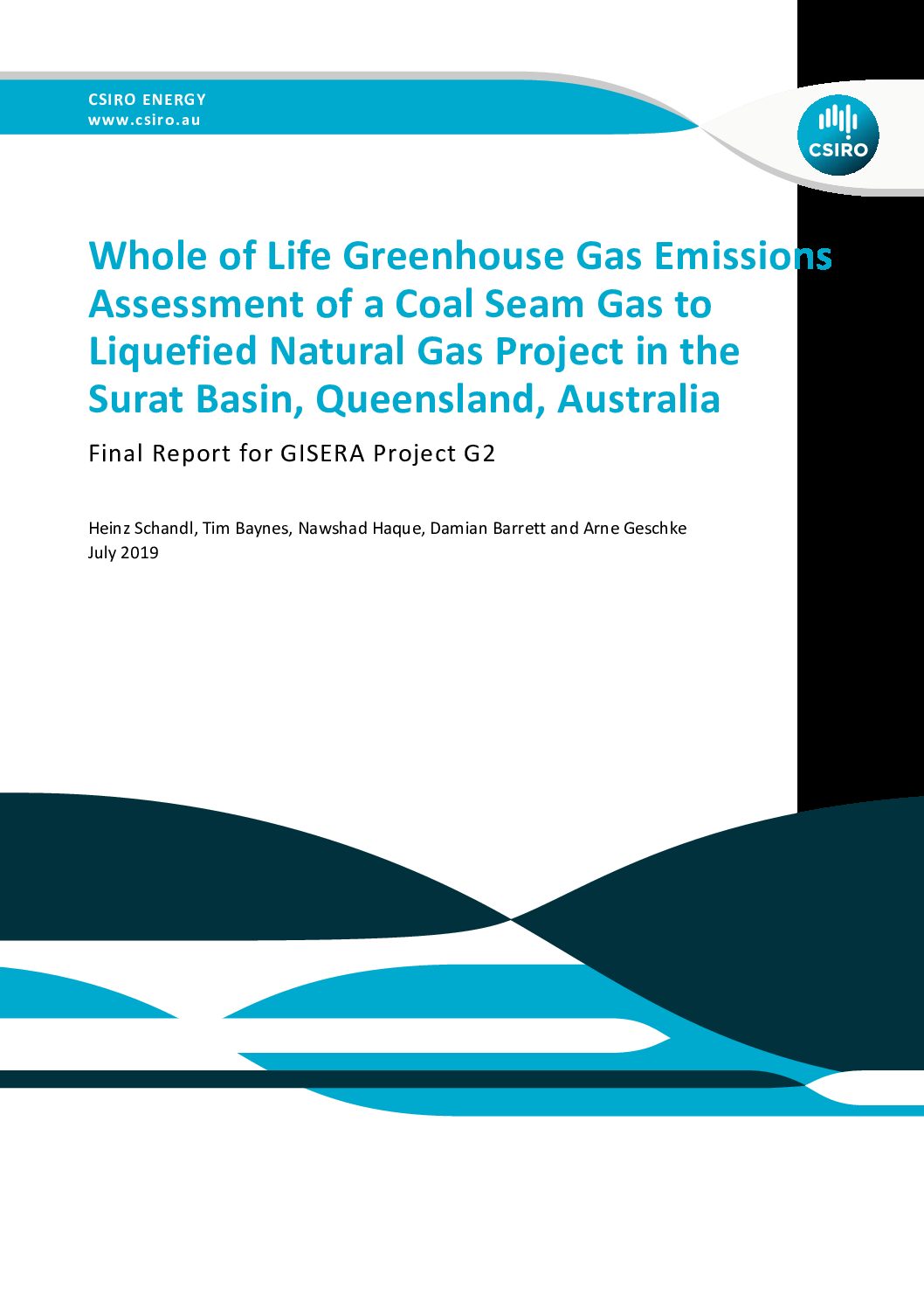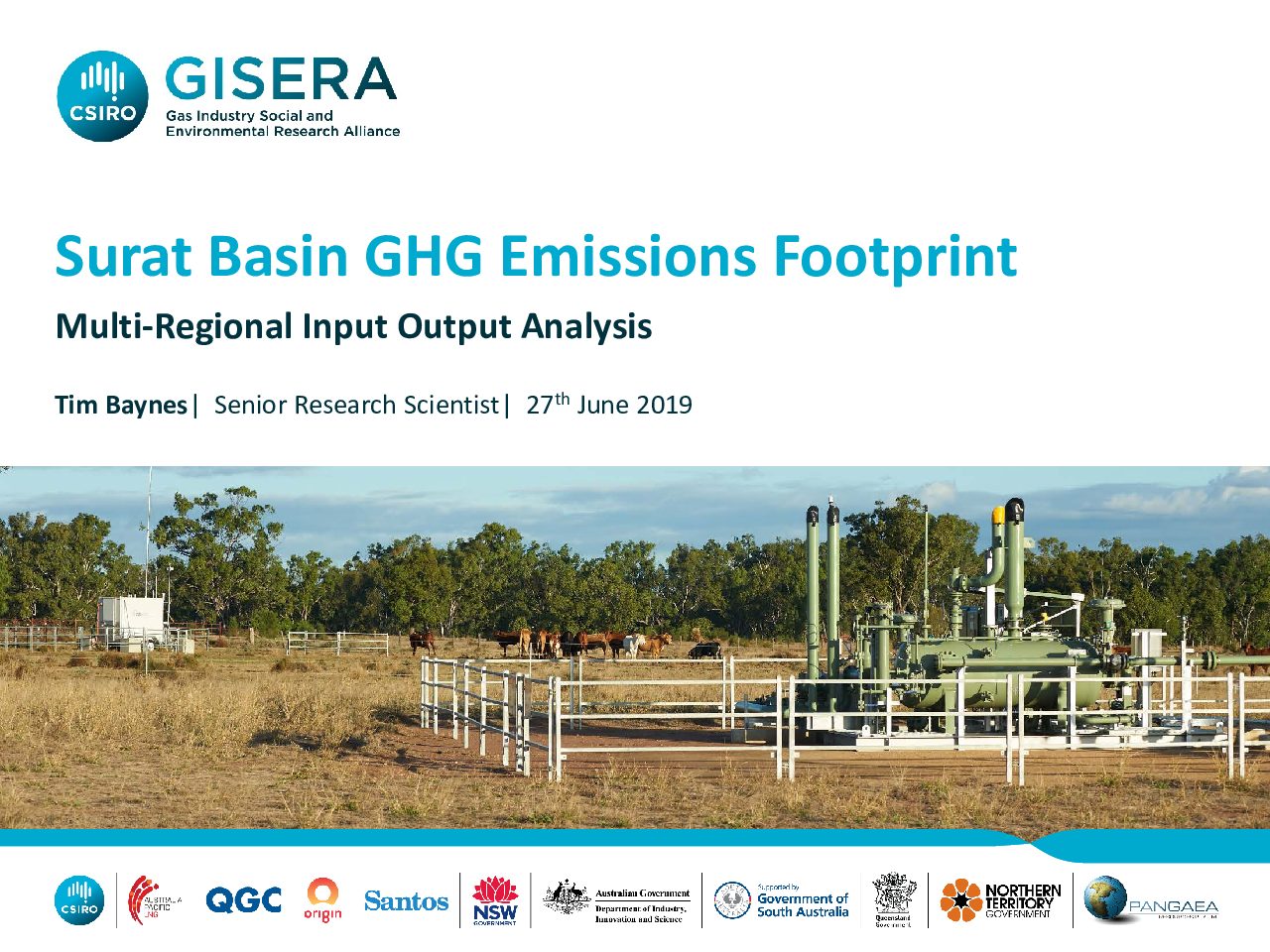Whole of life cycle greenhouse gas assessment
This project analysed whole of life GHG emissions, including extraction, transportation and usage of CSG in the Surat Basin.
The analysis includes domestic and offshore usage of the gas including for electricity generation in Asia. The project will provide assessments of benefits and risks related to the extraction, transport and usage of gas in terms of their GHG emission footprint.
Results of this research build on previous CSIRO studies to help build a more comprehensive and accurate picture of fugitive methane and other greenhouse gases associated with the unconventional onshore gas industry in Australia.
Watch this short animation to learn more about what the latest CSIRO research is telling us about fugitive emissions from the Queensland coal seam gas to liquefied natural gas industry.
[The CSIRO logo and text appears: GISERA, Gas Industry Social and Environmental Research Alliance]
Narrator: What the latest scientific research is telling us about greenhouse gas emissions from the Queensland Onshore Natural Gas Industry.
[Animation image appears of a world globe and then the image changes to show a LNG plant and then the animation image changes to show structural symbols of various chemicals including methane]
As countries seek reliable energy sources the liquified natural gas, LNG industry is growing but natural gas emissions are of concern to communities, government and industry.
[Animation images move through to show a gas pipe leading to a stove with a pot on top of it, a gas extraction station, and then a symbol of the molecular makeup of methane next to a question mark]
We know a lot about greenhouse gas emissions when natural gas is combusted but less about the emissions generated by the extraction and production of LNG.
[Animation image changes to show a pair of scales with LNG on one side and Coal on the other and the image shows the scale swinging back and forth]
And if production of LNG generates too much greenhouse gas the climate benefits of replacing coal are lost.
[Animation image changes to show a symbol of a laboratory experiment showing beakers and test tubes below a text heading: CSIRO GISERA, Gas Industry Social and Environmental Research Alliance]
The CSIRO has completed a range of studies since 2012 to help understand greenhouse gas emissions associated with the Queensland LNG industry.
[Animation image changes to show a cloud either side of text “CSG – LNG” and below this a line diagram appears showing the process from drilling the well to the useable gas and text appears: CO2.e = 1.4%]
By looking at the greenhouse gas emissions for the whole production chain for a Coal Seam Gas to LNG project in the Surat Basin these studies have found greenhouse gas emissions from a CSG – LNG project in Queensland are around 1.4% of production.
[Animation image zooms in on the first three steps of the process of drilling for the gas and processing it and text appears above: CH4 = 0.5%]
Fugitive methane emissions from upstream gas production infrastructure is less than 0.5% of production.
[Camera zooms in on the first step showing the well and text appears above: CH4 = 0.3%]
Fugitive methane emissions from CSG wells and casings in the Surat Basin is less than 0.3% of production.
[Animation image changes to show two cattle on one end of a line diagram and the gas well on the other end and a pie graph appears above and text appears around the pie graph: Grazing cattle = 54%, Feedlots = 24%, Other = 14%]
Grazing cattle, feedlots, cattle, poultry, piggeries, and CSG operations are the main sources of methane emissions in the Surat Basin.
[Animation image changes to show a line diagram beginning with the LNG plant and ending with an electricity pole and text appears: Could reduce GHG emissions, Dependent on fuel prices]
Using Queensland LNG to generate electricity in Asia could reduce greenhouse gas emissions if it replaces the use of thermal coal but this depends on the relative prices of different fuel types.
[Animation image changes to show a world globe and text appears above: Could reduce GHG emissions by up to 50%]
In Australia replacing thermal coal with Queensland coal seam gas to generate electricity could reduce greenhouse gas emissions by up to 50%.
[Animation image changes to show jigsaw pieces gradually being slotted in to fill the whole screen and then the camera zooms out to show the jigsaw pieces forming a map of Australia]
The CSIRO will continue research on greenhouse gas emissions from natural gas to assist the Commonwealth Government in obtaining accurate data for Australia’s national greenhouse gas inventory.
[Text appears: CSIRO, GISERA, Gas Industry Social and Environmental Research Alliance, To find out more about the latest emissions research, go to https://gisera.csiro.au]
To find out more about the latest emissions research go to the GISERA website.
July 2019





